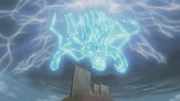Kirin is an extremely powerful Lightning Release technique created by Sasuke Uchiha.
Overview
Sasuke draws natural lightning directly from thunder clouds to supplement the power of his strike and controls it with chakra. Unlike most techniques, which are based on the user's chakra, this one uses the natural lightning, which — as noted by Zetsu — reaches the ground in 1/1000th of a second. However, the preparation time required also decreases the technique's efficiency. If there are no active thunder clouds, the user must create them by using powerful fire techniques to produce the necessary storm conditions. With techniques such as Amaterasu, even stronger storm conditions can be made by them.
Once a lightning source has been acquired, shaping and guiding the lightning to the target requires very little chakra. This technique was powerful enough to completely obliterate a small mountain and Itachi Uchiha's Susanoo.
Using this technique disperses the thunder clouds, and as such, it can only be used once in a fight. Conversely, however, because of the inextinguishable properties of techniques such as Amaterasu, it can be used to continuously create new thunder clouds to use Kirin once again; however, the process seems to require a bit of time.
Influences
- In Japanese mythology, the Kirin is considered a holy creature, whose cry is a musical scale and whose footprints are perfect circles. It is very peaceful and careful, capable of walking on water and on grass without bending the blades. It doesn't eat meat either. It only appears in places ruled by a benevolent and wise leader and is well-known for punishing the wicked.
- In Japan, the Kirin is considered as the most powerful and divine as opposed to the Hōō, the rulers of birds — and is usually placed above all other mythological creatures, including the ryū and Hōō. It can live up to a millennium and wounding one or coming across its corpse is considered a bad omen.
Trivia
- Kirin (キリン) is also the Japanese word for "giraffe".
- Interestingly, in episode 51 of the Naruto SD: Rock Lee no Seishun Full-Power Ninden anime, when Sasuke uses this technique, a giraffe appears instead of a dragon.
- In Naruto Shippūden: Ultimate Ninja Storm 2 , Naruto Shippūden: Ultimate Ninja Storm Generations, Naruto Shippūden: Ultimate Ninja Storm 3, and Naruto Shippūden: Ultimate Ninja Storm Revolution Sasuke has three chances of hitting the opponent with lightning from the sky, which when hit, will execute Kirin.
- The word "Kirin" (麒麟, Chi: Qílín) actually consists of two kanji where '麒' (ki, Chi: qí) is kanji for male Kirin and '麟' (rin, Chi: lín) is kanji for female Kirin.
- In Naruto Shippūden: Ultimate Ninja Heroes 3, Sasuke can use Kirin using his sword.
- In Rock Lee's Springtime of Youth Full Power Ninja Chronicles, Kirin is literally a giant giraffe head that descends from the sky, once to kiss Sasuke to activate his trump card and the second time just to say "Giraffe".


